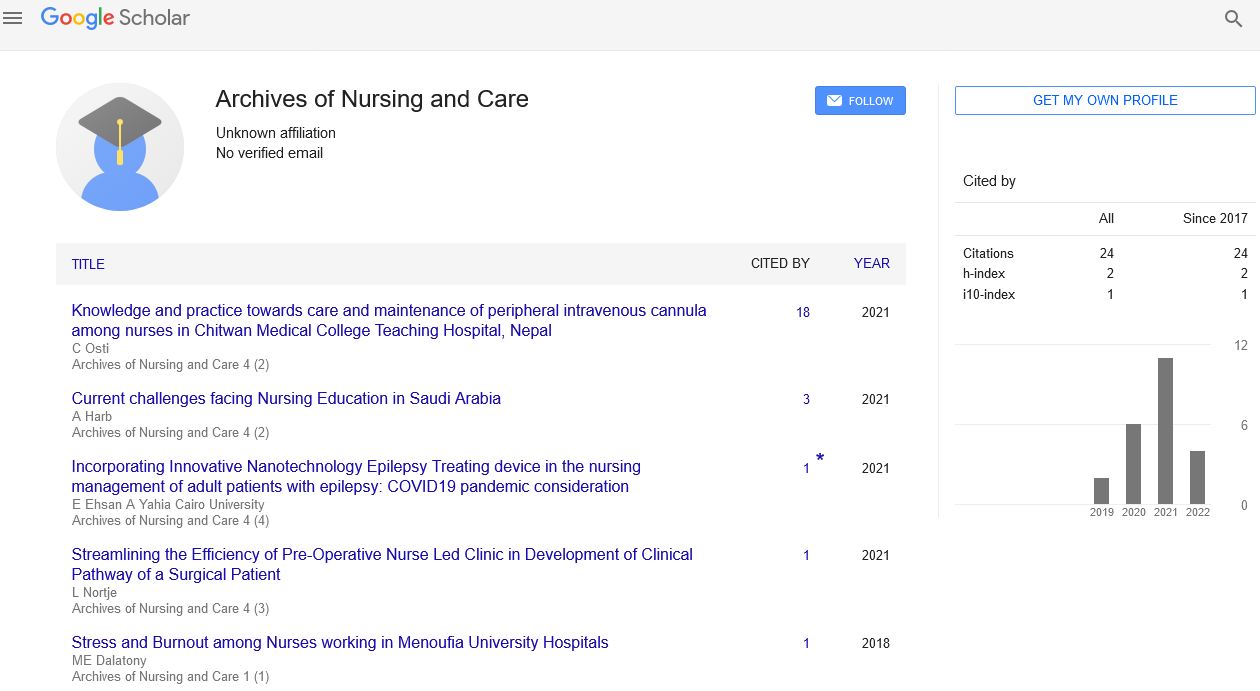Short Article - Archives of Nursing and Care (2018) Volume 1, Issue 3
Sepsis in the Neonate - Nurses' knowledge
Anna Rozensztrauch, Marzena Terpilowska, Teresa Malgorzata Trebenda, Kinga Tulacz and Marta BerghausenMazur
Wroclaw Medical University, Wroclaw, Poland
Abstract
Statement of the Problem: Neonatal infections can be caused by extraordinary variety of microorganism and can present many specific features. Most neonatal bacterial infections have an early bacteraemic phase preceding the development of a full-blown septicaemia or the localization of infection in organs and tissues. Progression from mild symptoms to death can occur in less than 24 hours. In preterm infants, early-onset neonatal sepsis (EOS) is most consistently defined as occurring in the first 3 days of life and is caused by bacterial pathogens transmitted vertically from mother to infant. In the early stages, signs are subtle and often noted first by the nurses or the mother. Such concerns must always be taken seriously and should not be overridden by the findings of a single clinical examination, especially when risk factors for sepsis are present. Methodology & Theoretical Orientation: A seven-day-old girl with hypoperfusion, thrombocytopenia, hypoglycemia and respiratory distress was referred to NICU for treatment (birth weight: 2150 g). Physical examination revealed lethargic girl, required intubation within 1 hour of admission and placed on HFOV. Blood culture positive with gram negative bacilli, later identified as E.coli. Urine and cerebrospinal fluid cultures remained sterile. Conclusion & Significance: Early recognition, diagnosis and treatment of serious infection in the neonate is essential because of the risk of permanent morbidity or mortality.
Introduction: Neonatal infections can be caused by extraordinary variety of microorganism and can present many specific features. Most neonatal bacterial infections have an early bacteraemic phase preceding the development of a full-blown septicaemia or the localization of infection in organs and tissues. Although advances in neonatal care, the risk of neonatal sepsis increases with decreasing birth weight and gestation age [1, 2, 3]. Sepsis is the commonest cause of neonatal mortality and is responsible for 30 – 50% of the total neonatal death each year in developing countries [4]. The most common organism’s cases of early-onset neonatal sepsis (EOS) in developed countries, are Escherichia coli (E.coli) and Streptococcus agalactiae, whereas in developing world most commonly is Klebsiela spp, S. aureus and E.coli [5].
Progression from mild symptoms to death can occur in less than 24 hours. In preterm infants, EOS is most consistently defined as occurring in the first 3 days of life and is caused by bacterial pathogens transmitted vertically from mother to infant [6,]. In the early stages, sign are subtle and often noted first by the nurses or the mother, recognize that something is “just not right” but is unable to describe any specific physical sign or symptom. The nonspecific features may include poor feeding, feeding intolerance, lethargy, temperature instability, respiratory distress, poor perfusion, bradycardia, tachycardia, apnea, glucose instability, irritability or unexplained jaundice. Such concerns must always be taken seriously and should not be overridden by the findings of a single clinical examination, especially when risk factors for sepsis are present [7]. In most cases, early recognition and treatment can prevent the complications of sepsis. Diagnostic tests should be completed before antibiotic therapy is initiated
Methodology & Theoretical Orientation
A seven-day-old girl with hypoperfusion, thrombocytopenia, hypoglycemia and respiratory distress was referred to Neonatal Intensive Care Unit (NICU) for treatment (birth weight: 2150 g). Physical examination revealed lethargic girl, required intubation within 1 hour of admission and placed on HFOV. Blood culture positive with gram negative bacilli, later identified as E.coli. Urine and cerebrospinal fluid cultures remained sterile.
Conclusion & Significance
Early recognition, diagnosis and treatment of serious infection in the neonate is essential because of the risk of permanent morbidity or mortality. The most common complications of bacterial sepsis are meningitis and septic shock. The outcome is influenced by early recognition and vigorous treatment with appropriate antibiotics and supportive care. All infants considered at risk should be closely observed for the development of the often subtle signs and symptoms of sepsis. Thorough documentation of the infant’s behavior during shift allows nurses to determine whether the behavior they observe is different or abnormal for infant. The nurse should immediately notify the physician if any changes are observed in the infant’s respiratory status, muscle tone, activity level or temperature or if the infant lacks interest in or does not tolerate feedings [8].
Parents who have infants with sepsis require support and information about their infant’s condition. Questions arise about treatment and prognosis, as well as possible long – range effects of the infections. Parents experience significant quilt feeling based on misperceptions about what role they had in causing infection. Health care professionals should remain sensitive to the crisis that parents are experiencing and address the issues of etiology, as well as treatment and prognosis. Valid and factual data, as well as information about complications and long – term effects, should be shared with parents in a timely manner
Controlling infection in the NICU is of prime importance but does not include excluding the parents from caring for their sick infant. Parents must adhere to proper handwashing, gowning, and isolation techniques. Educating the parents and siblings about the importance of these procedures, along with appropriate reminders, ensures cooperation. With proper precautions, there is no evidence of increase incidence of infection with parent and sibling visits. All those entering the NICU must be screened for the presence of illness. Anyone with a fever, respiratory (cough, runny nose, sore throat), gastrointestinal symptoms (nausea, vomiting, diarrhea), or skin lesion should not come in contact with the infant. People with communicable disease (e.g., varicella) or recent exposure to a communicable disease also should not come in contact with the sick neonate. Every parents should be taught the signs and symptoms of neonatal illness, because early recognition of signs and symptoms expedites prompt treatment. Parents must be taught to take axillary temperatures and to read a thermometer. They should be aware that both hypothermia and hyperthermia may be signs of neonatal illness [9].
References
- Shah BA, Padbury JF. Neonatal sepsis: An old problem with new insights. Virulence 2014; 5(1):1-9.].
- Hornik CP, Fort P, Clark RH, Watt K, Benjamin DK, Jr, Smith PB et all. Early and late onset sepsis in very-low-birth-weight infants from a large group of neonatal intensive care units. Early Hum. Dev 2012; 88:S69–S74.
- Birju A Shah, James F Padbury. Neonatal sepsis: An old problem with new insights. Virulence. 2014 Jan 1; 5(1): 170–178.
- Aijaz N., Huda N., Kausar S. Disease Burden of NICU. Vol. 6. Karachi, Pakistan: Tertiary Care Hospital; 2012
- Sivanandan S, Soraisham AS, Swarnam K. Review article: Choice and duration of antimicrobial therapy for neonatal sepsis and meningitis. Int J Pediatr 2011; 2011: 1-9.
- Simonsen KA, Anderson-Berry AL, Delair SF, Davies HD. Early-onset neonatal sepsis. Clin Microbiol Rev 2014; 27(1): 21-47.
- Kari A. Simonsen, Ann L. Anderson-Berry, Shirley F. Delair, H. Dele D. Early-Onset Neonatal Sepsis. Clin Microbiol Rev. 2014 Jan; 27(1): 21–47
- James SR, Nelson KA, Aswill JW. Nursing Care of Children: Principles and Practice. Fourth Edition. Elsevier, 2013.
- American Academy of Pediatrics: Report of the Committee on Infection Disease, ed 26, Elk Grove Village, I11, 2003.

